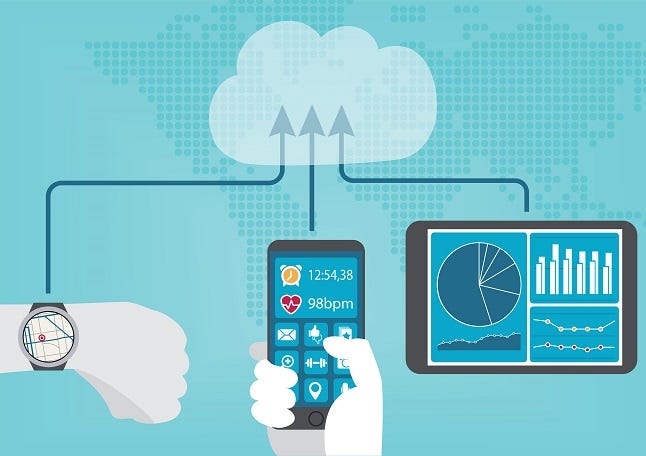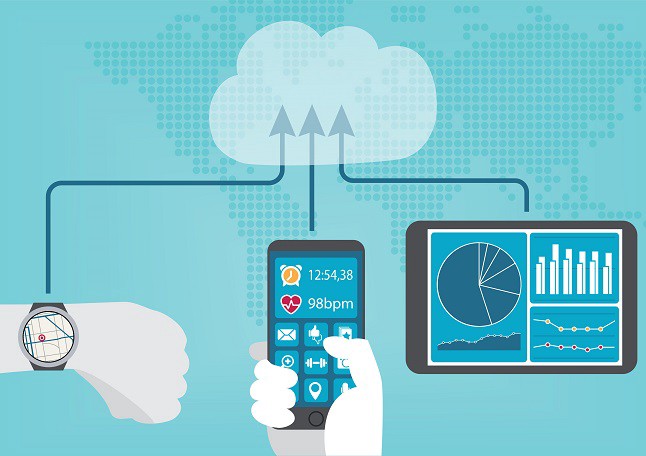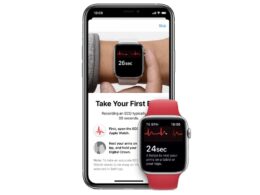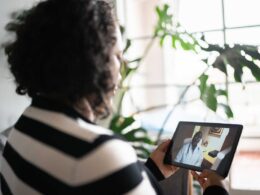Digital disruption that previously hit retail, financial services and many other sectors is now descending on healthcare.
Information Week
Samuel Greengard
June 02, 2022
Executive Summary
by Joaquim Cardoso MSc.
Transform Health
Research Institute for Continuous Health Transformation
June 12, 2022
What is the context?
- For more than a quarter of a century, pundits and prognosticators have said that a revolution was forthcoming for connected healthcare.
- Yet it wasn’t until early 2020, when the pandemic arrived, that there was a sudden and urgent need to pivot to a connected framework.
- Over the last few years, technology for connected healthcare has taken a big leap forward.
What is the impact? What are the opportunities?
- This rapid shift to connected healthcare has unleashed shockwaves.
- For healthcare executives, the stakes are enormous.
- There are remarkable opportunities to drive cost and quality improvements but also introduce new products and services …
Health Wear for Healthcare
- Smart watches and other wearables gather broader, richer, and more detailed information about health and wellness than what doctors and other medical professionals collect through conventional methods.
- A growing number of these devices have received FDA clearance.
- The data from personal health and wellness devices can be used by an individual to monitor themselves between doctor visits as well as to prompt a visit for a previously undiagnosed condition …
- Yet, this data can also be used by healthcare organizations and insurance providers to conduct research — and view aggregate statistics and trends that weren’t easily visible in the past.
- In the end, this model leads to “new and convenient patient-centric models of care, informed by evidence-based best practices,” …
Rx for Success (The case for connected health technology)
- Many healthcare providers “underutilize connected health technology and the data it can provide,” he says
- Despite spiraling costs, many organizations have little incentive to adopt connected health frameworks because they don’t perceive there is direct monetization, Schooley says.
- However, gaining insights into sleep patterns, gait steadiness, heart rate, muscle mass, blood oxygen saturation levels, behavioral habits, and many other factors could eliminate blind spots and fulfill mission statements that are focused on delivering high-quality healthcare.
Case studies
- A few healthcare organizations are beginning to adopt changes.
- For example, United Healthcare offers financial rewards and credits to health savings accounts for members that meet basic monthly step requirements, visit their primary care provider for an annual checkup and engage in other health-positive activities.
- These can add up to more than $120 per month.
Connections Matter
- Business and IT leaders who ignore connected healthcare do so at their own peril. Patients are adopting it as survey shows.
- At some point — and there’s some indication that it’s already happening — consumer companies like Apple, Withings, Ōura and Fitbit will steal away opportunities for new products and services.
- Already, drug store chains and smaller and more disruptive companies are establishing footholds, and new and innovative healthcare products are appearing.
What are some of the requirements?
- Establishing an IT foundation to support connected health is vital.
- Yet, it’s clear that a seismic change is underway. “The use of patient portals, and the incorporation of augmented intelligence in clinical decision support have all contributed to a transformational shift,”
- Connected devices could also play a major role in areas as diverse as emergency services and assisted care, particularly as 5G takes hold.
Conclusion and Recommendations
- “The future health ecosystem is about inter-connectedness within a new health ecosystem.
- Organizations must think beyond operational improvements and embrace human-centered innovation.”
- Healthcare executives must adopt a different mindset — and greatly expand their thinking about the connected technology space and what it can deliver.
- The goal isn’t simply to support video consults that allow doctors to see more people faster.
- “Remote patient monitoring … can indicate if there is a potential new condition that needs to be monitored,”
Structure of the publication
- Introduction
- Health Wear for Healthcare
- Rx for Success
- Connections Matter
ORIGINAL PUBLICATION (full version)

Introduction
For more than a quarter of a century, pundits and prognosticators have said that a revolution was forthcoming for connected healthcare.
Yet it wasn’t until early 2020, when the pandemic arrived, that there was a sudden and urgent need to pivot to a connected framework.
Suddenly, doctors and other medical professionals began substituting in-person visits with video consults and remote monitoring.
Smart watches, digital thermometers and blood oximeters played a crucial role in collecting and sharing data.
This rapid shift to connected healthcare has unleashed shockwaves.
“COVID has pushed electronic health and wellness devices into the forefront,” says Allyson Hein, medical device industry lead for Clarkston Consulting.
“These systems and devices have the potential to completely reshape care.”
For healthcare executives, the stakes are enormous.
Disruption that previously hit retail, financial services and many other sectors is now descending on healthcare. “
There are remarkable opportunities to drive cost and quality improvements but also introduce new products and services,” says Benjamin Schooley, associate professor of Integrated Information Technology at the University of South Carolina.
There are remarkable opportunities to drive cost and quality improvements but also introduce new products and services …

Health Wear for Healthcare
Over the last few years, technology for connected healthcare has taken a big leap forward.
One of the ironies is that smart watches and other wearables gather broader, richer, and more detailed information about health and wellness than what doctors and other medical professionals collect through conventional methods.
A growing number of these devices have received FDA clearance.
One of the ironies is that smart watches and other wearables gather broader, richer, and more detailed information about health and wellness than what doctors and other medical professionals collect through conventional methods.
“Only 20% of what keeps an individual healthy is contained in a typical clinical record,” says Rachel Hall, US Consulting Digital Health and Smart Health Experience Leader for consulting firm EY.
She notes that the accuracy of wearables and connected medical technology has improved dramatically in recent years, and they can fill many of the gaps.
“Only 20% of what keeps an individual healthy is contained in a typical clinical record,” …
… the accuracy of wearables and connected medical technology has improved dramatically in recent years, and they can fill many of the gaps.
For example, Apple Watch delivers insights into activity level, heart health, sleep, balance, blood oxygen levels and more.
Combined with other consumer devices, such as a connected scale or blood pressure monitor, it’s possible to gain deeper insights into a person’s health status.
The Ōura ring uses research-grade sensors to track heart rate, sleep and blood oxygen. It also uses deep learning algorithms to detect illness, including COVID-19.
In some cases, connected technology complements medical-grade devices, but it can also serve as a low-cost alternative.
They also complement other tools and methods, including IoT, mobile interactions, telehealth, remote diagnostics, artificial intelligence and even emerging technologies like virtual reality, augmented reality and mixed reality.
“The data from personal health and wellness devices can be used by an individual to monitor themselves between doctor visits as well as to prompt a visit for a previously undiagnosed condition,” Hein says.
Some apps allow users to send data directly to healthcare professionals, others generate PDFs.
This capability can be especially useful for older and disabled patients, as well as those living in rural and remote areas that lack easy access to care.
“The data from personal health and wellness devices can be used by an individual to monitor themselves between doctor visits as well as to prompt a visit for a previously undiagnosed condition …
Yet, this data can also be used by healthcare organizations and insurance providers to conduct research — and view aggregate statistics and trends that weren’t easily visible in the past.
For example, various universities and research institutions are conducting long-term studies through Apple Health on hearing, heart and movement and women’s health.
The sensors on the watch supply much of the data.
“Potential study subjects are no longer limited by distance from a study site that requires time and cost to travel to. There is also no lost time at work or childcare considerations,” Hein points out.
In the end, this model leads to “new and convenient patient-centric models of care, informed by evidence-based best practices,” …
… says Karen S. Rheuban, MD, Director, UVA Center for Telehealth at the University of Virginia Health Systems, and co-chair of the Digital Medicine Payment Advisory Group for the American Medical Association

Rx for Success
Tight budgets and technical complexities are no stranger to healthcare organizations. However, Schooley says the problems run deeper.
Many healthcare providers “underutilize connected health technology and the data it can provide,” he says.
Many healthcare providers “underutilize connected health technology and the data it can provide,” …
Despite spiraling costs, many organizations have little incentive to adopt connected health frameworks because they don’t perceive there is direct monetization, Schooley says.
However, gaining insights into sleep patterns, gait steadiness, heart rate, muscle mass, blood oxygen saturation levels, behavioral habits, and many other factors could eliminate blind spots and fulfill mission statements that are focused on delivering high-quality healthcare.
Despite spiraling costs, many organizations have little incentive to adopt connected health frameworks because they don’t perceive there is direct monetization …
A few healthcare organizations are beginning to adopt changes.
For example, United Healthcare offers financial rewards and credits to health savings accounts for members that meet basic monthly step requirements, visit their primary care provider for an annual checkup and engage in other health-positive activities.
These can add up to more than $120 per month.
United Healthcare offers financial rewards and credits to health savings accounts for members that meet basic monthly step requirements, visit their primary care provider for an annual checkup and engage in other health-positive activities.
Members fill in data or sync their devices through a button at the website.
It uses a series of APIs to collect and manage the data through apps such as Withing’s Healthmate, which pulls data about steps and other factors from Apple Watch and the company’s own set of smart watches and wearables.
Hall believes that healthcare executives must adopt a different mindset — and greatly expand their thinking about the connected technology space and what it can deliver.
The goal isn’t simply to support video consults that allow doctors to see more people faster.
“Remote patient monitoring … can indicate if there is a potential new condition that needs to be monitored,” she says.
“Remote patient monitoring … can indicate if there is a potential new condition that needs to be monitored,” she says.

Connections Matter
Business and IT leaders who ignore connected healthcare do so at their own peril.
A study from Doctor.com found that
- 83% of patients using telemedicine plan to continue with it after the pandemic. In addition,
- 68% prefer to use their mobile phone to make appointments and handle other tasks, and
- 91% say that connected tech is valuable for managing prescriptions and compliance.
At some point — and there’s some indication that it’s already happening — consumer companies like Apple, Withings, Ōura and Fitbit will steal away opportunities for new products and services.
Already, drug store chains and smaller and more disruptive companies are establishing footholds, and new and innovative healthcare products are appearing.
“There are growing opportunities for data and app-related services, apps, subscriptions and more but traditional healthcare providers often don’t see this,” Schooley points out.
Establishing an IT foundation to support connected health is vital.
Hall says this includes a cloud-first architecture, integrating IoT and edge technologies, focusing on data standards, building more sophisticated and interactive apps, exploring partnerships, and cultivating skillsets needed to support both innovation and operations.
“Interoperability, data aggregation and data insights are critical. Executives should be focused on creating value,” she explains.
Hein says that it’s wise to identify doctors, nurses and other practitioners who are enthusiastic about pilot projects — and then explore and test various concepts.
She also recommends establishing an advisory board to track technical controls surrounding HIPAA while ensuring that strong security and privacy controls are in place.
Yet, it’s clear that a seismic change is underway. “The use of patient portals, and the incorporation of augmented intelligence in clinical decision support have all contributed to a transformational shift,” Rheuban says.
Connected devices could also play a major role in areas as diverse as emergency services and assisted care, particularly as 5G takes hold.
Connected devices could also play a major role in areas as diverse as emergency services and assisted care, particularly as 5G takes hold.
Says Hall: “The future health ecosystem is about inter-connectedness within a new health ecosystem. Organizations must think beyond operational improvements and embrace human-centered innovation.”
“The future health ecosystem is about inter-connectedness within a new health ecosystem. Organizations must think beyond operational improvements and embrace human-centered innovation.”
Originally published at https://www.informationweek.com on June 2, 2022.
NAMES MENTIONED
Allyson Hein, medical device industry lead for Clarkston Consulting.
Benjamin Schooley, associate professor of Integrated Information Technology at the University of South Carolina.
Rachel Hall, US Consulting Digital Health and Smart Health Experience Leader
Karen S. Rheuban, MD, Director, UVA Center for Telehealth at the University of Virginia Health Systems, and co-chair of the Digital Medicine Payment Advisory Group for the American Medical Association












